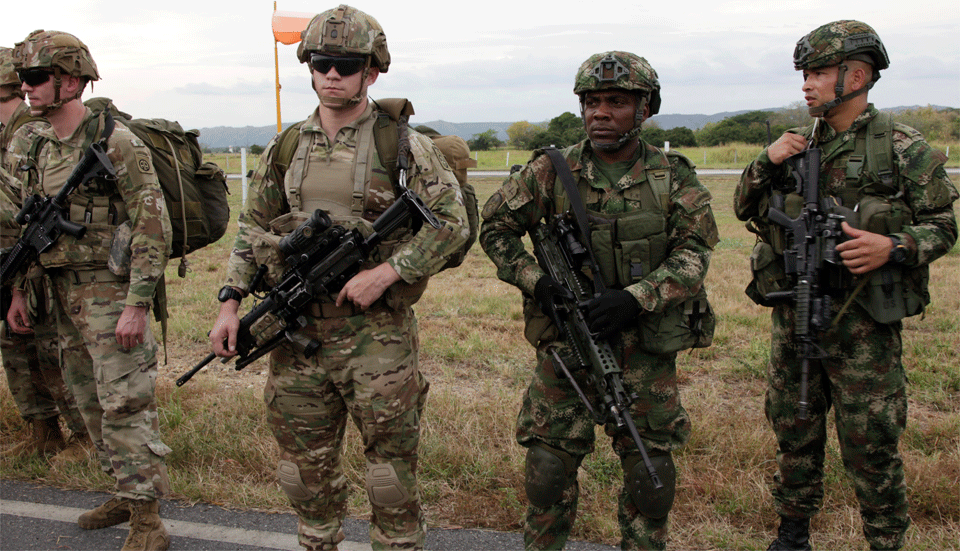
The United States Embassy in Bogotá announced on May 28 that the U.S. is sending 50 or so soldiers of the Army’s 1st Security Force Assistance Brigade (SFAB) to Colombia. They would be carrying out consultations with Colombian Army commanders and providing them with technical assistance, both in order to fight narco-trafficking. The collaboration will play out in rural areas once occupied by the Revolutionary Armed Forces of Colombia (FARC) insurgency, places where Colombian Army units supposedly are establishing a state presence.
They arrived on or about June 1 and will remain for four months. The COVID-19 pandemic is hitting Colombia hard, and the soldiers are presently spending 14 days in quarantine before beginning work. The Brigade has served in Afghanistan, Africa, and Europe, and now is in Latin America for the first time.
Their deployment has provoked little or no comment from the U.S. media or politicians. That the deployment goes forward despite pandemic, economic collapse, and nationwide protests against a police killing suggests little will daunt U.S. assertions of power in Latin America.
For U.S. governments to use the drug war as pretext for adventures in Colombia is routine. The Clinton administration’s Plan Colombia, a multibillion-dollar military aid project in force for more than a decade, is one example. U. S. support for Colombia’s military traces back to the U.S.-sponsored Inter-American Treaty of Reciprocal Assistance of 1947. The new contingent will be joining U.S. military personnel and civilian contractors in place in Colombia under the auspices of Plan Colombia. The U.S. military took over all or part of seven Colombian air bases, under an agreement in 2009.
The larger framework of U.S. military involvement in Colombia relates to U.S. efforts to suppress progressive political movements in the region and remove leftist governments, and also to offer further assistance formerly provided to the Colombian government in fighting the Marxist-oriented FARC insurgency.
There’s no benign reason for a few dozen U.S. military in the view of many Colombians. Some see their presence there as illegal inasmuch as the Constitution requires that their entry be approved by the Colombian Senate. Others, Colombia’s Communist Party, for example, regard the matter as a violation of Colombia’s national sovereignty.
Activities of the SAFB seem likely to involve these U.S. troops in Colombian domestic politics. They may be joining Colombian Army elements involved in promoting—not ending—the illegal drug trade. And through the SAFB, the U.S. military may be taking up its accustomed role in Colombia’s counterinsurgency wars. On both counts, the U.S. government would be undermining the 2016 peace agreement the Colombian government signed with the FARC.
To explain: Troops of the SAFB will working with Colombian Army units posted in five areas of rural Colombia designated in 2018 as Zones of the Future (Zonas Futuro). These make up three percent of the country’s land area. Two of them are adjacent to Venezuela.
Colombian Army units posted to these areas engage in forcible destruction of coca that is produced there. The Peace Agreement called for conversion to the growing of substitute crops. Through their collaboration with Colombian troops the SAFB would be complicit in violating that accord.
The Zonas Futuro are homes to guerrillas, dissident FARC groups or leftist National Liberation Army (ELN) insurgents to whom the FARC peace agreement did not apply. In fighting guerrillas and dealing with coca growers the Colombian military relies on paramilitary troops. Suspicion is widespread that their job under any circumstance entails murder. Political and community leaders and former FARC combatants living in the Zonas Futuro are at high risk.
Since the Peace Agreement was signed, paramilitaries or somebody have killed hundreds of people in these categories. The association of the SAFB with Colombian soldiers, tied to the paramilitaries as they are, might require the U.S. troops to tolerate one more violation of the Peace Agreement.
U.S. designs on Venezuela, with Colombia assuming a big role, may have provided another draw that brought the SAFB to Colombia.
Step-by-step economic sanctions that began under the Obama administration in 2015 have set the stage for all-but-war against Venezuela, Colombia being first assistant. Sanctions on imports, exports, and debt servicing have led to vast shortages of essential goods. Venezuela’s economy took an additional hit through the seizure of the U.S.-based and Venezuelan-owned Citgo oil company and U.S. plunder of currency deposits in foreign banks.
The scenario has included the failed attempt in January 2019 of introducing aid material from Colombia to provoke desertions by Venezuelan soldiers, plus U.S.-Colombian land and sea military exercises carried out in early 2020 close to Venezuela.
The tempo increased in late March and early April with the dispatch of a naval fleet to Caribbean waters, call-up of U. S. Army reserves, and indictments of Venezuelan leaders—all on the usual pretext of fighting illegal drugs. On May 3-4, a small mercenary force trained in Colombia by former U.S. Special Forces troops failed in its attempt to invade Venezuela.
The late Venezuelan President Hugo Chávez has the last word on the significance of this new insertion of U.S power in Colombia. Chávez once pointed out that: “Unfortunately, Colombia is, strategically, the beachhead for Yankee strivings in South America, their base of operations. [They] send elite troops under a drug-war façade. So Colombia is a country occupied by foreign troops that has yet to stop the production and trafficking of drugs.”










